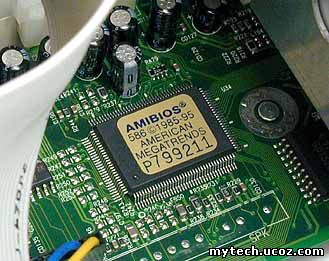The BIOS software has a number of different roles, but its most
important role is to load the operating system. When you turn on your
computer and the microprocessor tries to execute its first instruction,
it has to get that instruction from somewhere. It cannot get it from the
operating system because the operating system is located on a hard
disk, and the microprocessor cannot get to it without some instructions
that tell it how. The BIOS provides those instructions. Some of the other common tasks that the BIOS performs include:
- A power-on self-test (POST) for all of the different hardware
components in the system to make sure everything is working properly
- Activating other BIOS chips on different cards installed in the computer - For example, SCSI and graphics cards often have their own BIOS chips.
- Providing a set of low-level routines that the operating
system uses to interface to different hardware devices - It is these
routines that give the BIOS its name. They manage things like the keyboard, the screen, and the serial and parallel ports, especially when the computer is booting.
- Managing a collection of settings for the hard disks etc.
 The BIOS is special software that interfaces the major hardware components of your computer with the operating system. It is usually stored on a Flash memory chip on the motherboard, but sometimes the chip is another type of ROM.
When you turn on your computer, the BIOS does several things. Thisis its usual sequence:
- Check the CMOS Setup for custom settings
- Load the interrupt handlers and device drivers
- Initialize registers and power management
- Perform the power-on self-test (POST)
- Display system settings
- Determine which devices are bootable
- Initiate the bootstrap sequence
The first thing the BIOS does is check the information stored in a tiny (64 bytes) amount of RAM located on a complementary metal oxide semiconductor
(CMOS) chip. The CMOS Setup provides detailed information particular to
your system and can be altered as your system changes. The BIOS uses
this information to modify or supplement its default programming as
needed. We will talk more about these settings later.
Interrupt handlers are small pieces of software that
act as translators between the hardware components and the operating
system. For example, when you press a key on your keyboard, the signal
is sent to the keyboard interrupt handler, which tells the CPU what it
is and passes it on to the operating system. The device drivers
are other pieces of software that identify the base hardware components
such as keyboard, mouse, hard drive and floppy drive. Since the BIOS is
constantly intercepting signals to and from the hardware, it is usually
copied, or shadowed, into RAM to run faster.
|